Recovery Strategy for the Silver Hair Moss (Fabronia pusilla) in Canada: APPENDIX 1
APPENDIX 1
Recovery Strategy for the Silver Hair Moss (Fabronia pusilla Raddi) in British Columbia
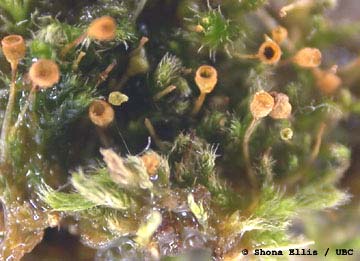
Prepared by the British Columbia Bryophyte Recovery Team

June 2007
Draft
TABLE OF CONTENTS
RECOVERY TEAM MEMBERS
AUTHOR
RESPONSIBLE JURISDICTIONS
ACKNOWLEDGMENTS
EXECUTIVE SUMMARY
BACKGROUND
Species Assessment Information from COSEWIC.
Description of the Species
Populations and Distribution
Needs of the silver hair moss
Habitat and biological needs
Threats
Knowledge Gaps
RECOVERY
Recovery Feasibility
Recovery Goal
Recovery Objectives
Approaches Recommended to Meet Recovery Objectives.
Recovery Planning Table
Description of the Recovery Planning Table
Performance Measures
Critical Habitat
Identification of the species’ critical habitat
Recommended schedule of studies to identify critical habitat
Existing and Recommended Approaches to Habitat Protection
Effects on Other Species
Socioeconomic Considerations
Recommended Approach for Recovery Implementation.
Statement on Action Plans
REFERENCES
About the British Columbia Recovery Strategy Series
This series presents the recovery strategies that are prepared as advice to the Province of British Columbia on the general strategic approach required to recover species at risk. The Province prepares recovery strategies to meet our commitments to recover species at risk under the Accord for the Protection of Species at Risk in Canada, and the Canada – British Columbia Agreement on Species at Risk.
What is recovery?
Species at risk recovery is the process by which the decline of an endangered, threatened, or extirpated species is arrested or reversed, and threats are removed or reduced to improve the likelihood of a species’ persistence in the wild.
What is a recovery strategy?
A recovery strategy represents the best available scientific knowledge on what is required to achieve recovery of a species or ecosystem. A recovery strategy outlines what is and what is not known about a species or ecosystem; it also identifies threats to the species or ecosystem, and what should be done to mitigate those threats. Recovery strategies set recovery goals and objectives, and recommend approaches to recover the species or ecosystem.
Recovery strategies are usually prepared by a recovery team with members from agencies responsible for the management of the species or ecosystem, experts from other agencies, universities, conservation groups, aboriginal groups, and stakeholder groups as appropriate.
What’s next?
In most cases, one or more action plan(s) will be developed to define and guide implementation of the recovery strategy. Action plans include more detailed information about what needs to be done to meet the objectives of the recovery strategy. However, the recovery strategy provides valuable information on threats to the species and their recovery needs that may be used by individuals, communities, land users, and conservationists interested in species at risk recovery.
For more information
To learn more about species at risk recovery in British Columbia, please visit the Ministry of Environment Recovery Planning webpage at:
<http://www.env.gov.bc.ca/wld/recoveryplans/rcvry1.htm >
Recovery Strategy for the Silver Hair Moss (Fabronia pusilla Raddi) in British Columbia
Prepared by the British Columbia Bryophyte Recovery Team
June 2007
Cover illustration/photograph
Shona Ellis/UBC
Disclaimer
This recovery strategy has been prepared by the British Columbia Bryophyte Recovery Team, as advice to the responsible jurisdictions and organizations that may be involved in recovering the species. The British Columbia Ministry of Environment has received this advice as part of fulfilling its commitments under the Accord for the Protection of Species at Risk in Canada, and the Canada – British Columbia Agreement on Species at Risk.
This document identifies the recovery strategies that are deemed necessary, based on the best available scientific and traditional information, to recover silver hair moss populations in British Columbia. Recovery actions to achieve the goals and objectives identified herein are subject to the priorities and budgetary constraints of participatory agencies and organizations. These goals, objectives, and recovery approaches may be modified in the future to accommodate new objectives and findings.
The responsible jurisdictions and all members of the recovery team have had an opportunity to review this document. However, this document does not necessarily represent the official positions of the agencies or the personal views of all individuals on the recovery team.
Success in the recovery of this species depends on the commitment and cooperation of many different constituencies that may be involved in implementing the directions set out in this strategy. The Ministry of Environment encourages all British Columbians to participate in the recovery of silver hair moss.
Recovery Team Members
British Columbia Bryophyte Recovery Team
Ted Lea (chair), Vegetation Ecologist, Ecosystems Branch, B.C. Ministry of Environment, Victoria, BC
Brenda Costanzo, Plant Species at Risk Biologist, Ecosystems Branch, B.C. Ministry of Environment, Victoria, BC
Karen Golinski Ph.D., private consultant
Terry McIntosh Ph.D., Botanist, Biospherics Environmental Inc., Vancouver, BC
Mike Ryan, B.C. Ministry of Forests and Range, Kamloops, BC
Wilf Schofield, Professor Emeritus, UBC Department of Botany, Vancouver, BC
Author
Terry McIntosh
Responsible Jurisdictions
The British Columbia Ministry of Environment is responsible for producing a recovery strategy for silver hair moss under the Accord for the Protection of Species at Risk in Canada. Environment Canada, Canadian Wildlife Service participated in the development of this recovery strategy.
ACKNOWLEDGEMENTS
This document was prepared by Terry McIntosh on behalf of the B.C. Bryophyte Recovery Team. Funding was provided by the Habitat Conservation Trust Fund and the B.C. Conservation Foundation.
EXECUTIVE SUMMARY
The silver hair moss is a tiny, creeping moss that grows in thin, flat mats over rock surfaces. It has been found in western North America, Mexico, Europe, and North Africa. In North America, it has been reported from southern British Columbia, Washington, Idaho, Oregon, Colorado, New Mexico, Arizona, and California. This species is restricted to southern British Columbia where it has been found at two locations: below McKee Peak at the west end of Sumas Mountain east of Abbotsford, and in the Arrow Lakes area in the southwestern part of the province, where it has probably been extirpated. Detailed population data are not available as this species has not been seen since its first report.
Little is known about the biological attributes that may influence the recovery potential of the silver hair moss. It does not appear to produce spores frequently in its Canadian range. In British Columbia, itis restricted to semi-shaded, sandstone rock faces or crevices, often alongside other species of mosses. Potential threats include urban development, recreation activities, and rock face degradation.
The critical habitat of this species cannot be identified until the species’ presence is reconfirmed. The potential habitat in Canada can generally be described as semi-shaded, sandstone rock faces or crevices, in low elevation, probably summer dry environments. Ecological studies and inventory could be completed.
The recovery goal is to confirm the presence of silver hair moss in Canada, and to protect and maintain any extant populations. Because the original population has not been rediscovered, there are no data for the habitat and ecology of this species in Canada; thus, current population viability cannot be estimated. Therefore, overall recovery feasibility is unknown until the species is rediscovered through inventory.
Recovery objectives include to inventory sites to relocate the original population; to implement habitat protection and threat mitigation for any extant populations; and to conduct scientific research on the ecology and habitat requirements of the populations, plus research on threats to the populations if found or rediscovered.
The broad strategy to address threats includes inventory to relocate the species, and if found, protect any extant populations and habitats by establishing stewardship agreements and covenants on private land, or other mechanisms on Crown land. Also, if the species is rediscovered, to conduct research on existing populations and habitats, potential threats to the habitats, known and potential threats, and changes in population attributes; and to initiate an education/stewardship program.
For successful implementation in protecting species at risk, there will be a strong need for stewardship on various land tenures.
BACKGROUND
Species Assessment Information from COSEWIC
Common Name: silver hair moss.
Scientific Name: Fabronia pusilla Raddi Nov. et Rar. Plant. 2. in Atti dell' Acad. Di Scienze di Siena 9:230 1808.
Status: Endangered.
Last Examination and Change: November 2002.
Canadian Occurrence: British Columbia.
Reason for Designation: silver hair moss is a small species that grows among other mosses, either as an epiphyte on trees or on rock faces. In Canada, it is known from two locations: one that is now submerged and a second associated with a cliff in southwestern British Columbia. The latter is the northernmost location for this species. Although the species was not relocated at its extant site during recent surveys, the expanse of available habitat at the only known sites, combined with small stature of the moss, suggests that the species may still be present in Canada.
Status History: Designated Endangered in November 2002. Assessment based on a new status report.
Description of the Species
The silver hair moss is a tiny, creeping moss that grows in thin, flat mats. It has narrow, irregular branched stems with leaves pressed against the stem along their length, except for the leaf tips which tend to bend outwards. Leaves range from 0.4 to 0.85 mm long and from 0.2 to 0.35 mm wide. The leaves are somewhat egg-shaped and have long, clear leaf tips or awns, each ending in a distinctive long cell. The upper two-thirds of the leaf margins are bordered by sharp, cilia-like teeth, with the terminal cells of the teeth usually much longer than the lower cells. The clear awns and teeth give the plant a silvery to whitish-green cast.
The silver hair moss has male and female organs on the same stem. Because of the proximity of sex organs, sporophytes are common in most populations. The erect to somewhat curved stalk that bears the capsule is about 3 mm long. Its capsules are erect, ovate to obovate, with somewhat wrinkled bases when mature.
Although the marginal teeth of the leaves are not readily visible in the field under the low magnification of a hand lens, its diminutive size, long leaf tips, and the general whitish-green cast help to distinguish this species. Its small size and habit of growing with other larger pleurocarpous (creeping and freely branched) mosses may result in the silver hair moss being overlooked in field surveys.
This description is based on information from COSEWIC (2002), Grout (1934), Lawton (1971), and Sharp et al. (1994). Figure 1 illustrates key features of this species and Figure 2 is a photograph of the plant including sporophytes. For additional illustrations refer to Lawton (1971) and Buck (1994).
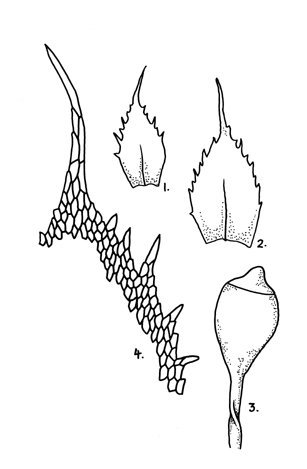
Figure 1. Illustrations of the silver hair moss (by T. McIntosh 2002): 1 and 2 are outlines of typical leaves (× ~80), 3 is a maturing capsule and upper portion of the seta (× ~40), and 4 shows details of the leaf margin and apex (× ~300; × ~80); illustrations redrawn from Lawton (1971) and Buck (1994), and from microscopic examination of material.
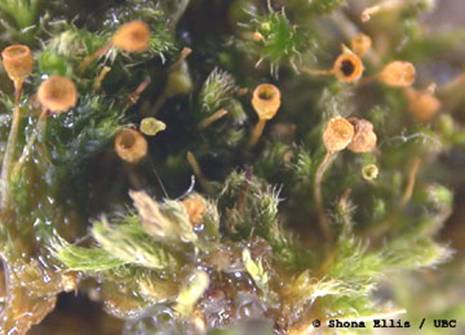
Figure 2. Plants of the silver hair moss with sporophytes (rehydrated from first provincial collection); from Species at Risk Act (SARA) website (Environment Canada 2004; photograph by S. Ellis).
Populations and Distribution
The silver hair moss has a western North American – western Europe/North African distribution, principally in Mediterranean-type, summer dry/winter wet climates. It has been found in western North America, Mexico, Europe, and North Africa (COSEWIC 2002). In North America, it has been reported from southern British Columbia, Washington, Idaho, Oregon, Colorado, New Mexico, Arizona, and California (Figure 3). The Canadian records are at the northern limit of the distribution of the silver hair moss in North America. It is more widespread and more plentiful southwards, especially in California.
In Canada, this species is restricted to southern British Columbia where it has been found at two locations: below McKee Peak at the west end of Sumas Mountain east of Abbotsford in the southwestern part of the province (Figure 4), and at Deer Park near Lower Arrow Lake in the Kootenay Valley in the south-central part of the province (Tan 1980). The Arrow Lake site is now submerged behind a dam (B.C. Tan, pers. comm., 2001), and the silver hair moss has not been collected from the area since Macoun’s collections in the late 1800s. It was last seen (and collected) at the Abbotsford site in March 1968. W.B. Schofield made two collections on the same date from sites near each other on Sumas Mountain (these are considered part of the same population; COSEWIC 2002); however, exact coordinates of these collections were not reported. It was not found by T. McIntosh and W.B. Schofield (who visited the site on two occasions with T. McIntosh) during fieldwork in 2001, 2003, and twice in 2005. Sites of similar sandstone habitat on Mount Maxwell, Saltspring Island, were surveyed by T. McIntosh in 2001, but this moss was not located.
Its North American distribution pattern, as well as its apparent preference for oak habitats in California, may indicate that the B.C. population is relictual in nature, possibly a remnant of a drier, oak-dominated ecosystem that was relatively extensive in the southern portions of the province during the warmer hypsithermal period some 6000–7000 years ago. A remnant stand of Garry oaks is present on Sumas Mountain about 10 km to the east of the silver hair moss site below McKee Peak.
No population data are available on the Canadian population of the silver hair moss (COSEWIC 2002; follow-up surveys did not relocate the species). Schofield did not collect any information about the population during his initial collection.
Table 1. Population data for the silver hair moss in Canada
Site |
Location coordinates |
Number of patches |
Land tenure |
|---|---|---|---|
Sumas Mountain (below McKee Peak) |
unknown |
unknown |
unknown |
Arrow Lake Area |
extirpated |
N/A |
N/A |
Globally, this species is tentatively considered common to uncommon but not rare (G4G5) and is Red-listed (S1) in British Columbia (B.C. Species and Ecosystem Explorer 2005). NatureServe Explorer (2005) lists itas not assessed for the United States (NNR), N1 (critically imperiled) ranking for Canada, S1 (critically imperiled) for Montana, S1 for Oregon, and S1 for British Columbia.
There are no reported estimations of global distribution and abundance for the silver hair moss. There are no detailed data on the size or trends of the Canadian population of this species as it has not been rediscovered since 1968.
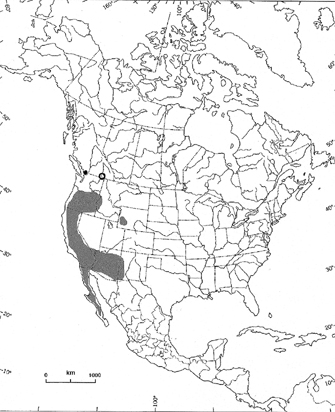
Figure 3. Approximate distribution of the silver hair moss in North America and Canada (gray area approximates the distribution in the United States, black dot is the Sumas Mountain Canadian location, and the circle is the extirpated Lower Arrow Lake location).
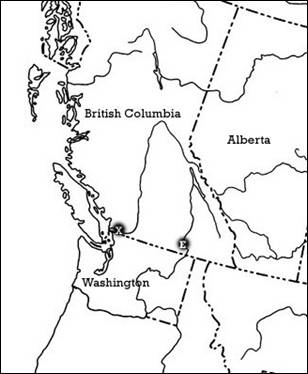
Figure 4. Distribution of silver hair moss in Canada (X = Sumas Mountain site; E = extirpated Arrow Lake site).
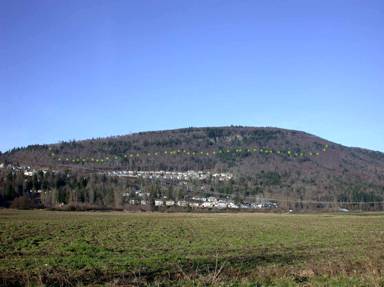
Figure 5. Sumas Mountain site with approximate extent of sandstone cliffs noted by yellow dots (length about 1.5 km).
Needs of the silver hair moss
Habitat and biological needs and limiting factors
There is little information about the habitat needs for the silver hair moss in British Columbia or elsewhere. In British Columbia, the reported population of the silver hair moss (at the Abbotsford site) is restricted to semi-shaded, sandstone rock faces or crevices, often alongside other species of mosses, in particular Homalothecium spp., in low elevation, summer dry environments. However, the exact location, and thus habitat, for this collection has not been determined. It was reported from crevices of steep rocks of undetermined type at the Arrow Lake site (now under water). Southwards in North America, it has been found in similar habitats as well as on tree bark, especially oaks (including Garry oak).
Little is known about the biological attributes that may influence the recovery potential of the silver hair moss. Although the silver hair moss produces sporophytes and spores frequently across the southern portions of its range, sporophytes are not abundant in the two Sumas Mountain collections at the University of British Columbia. Thus, reduced spore production may limit recovery. Also, there is no information on spore dispersal distances, viability, or germination success for this species, although moss spores in this type of habitat are most frequently wind-dispersed. The closed habitat where this species lives may restrict wind dispersal of spores. There is no evidence of asexual reproduction by specialized propagules or by fragmentation, and this may also limit its ability to disperse and recovery.
Another limiting factor may be size—this very tiny moss is smaller than other moss species that grow with it. Because of this, it may not have the competitive ability that adjacent mosses possess, and may require open, relatively bare rock surfaces to survive.
Threats
Until this species has been relocated, the following are considered to be potential threats.
Urban development on Sumas Mountain
A large area of dry Douglas-fir/big-leaf maple forest below the probable location where the silver hair moss was found on Sumas Mountain has recently been developed for residential use. However, the cliffs where this moss was found are over 80 m above this area, and this activity may not have affected the population. The City of Abbotsford’s McKee Peak Planning Study indicates that much of the land above the probable location could be subject to urban development in the next 10–15 years. The proposed development is approximately 800 ha, so would result in a significant number of people living near the cliffs.
Recreational activities
Hiking is common along narrow trails beneath the cliffs but no damage to bryophyte populations of other species on the outcrops was observed. Some rock climbing to small ledges and grottos was observed, but this activity is minor. However, given that there is a new housing development in progress below the cliffs, and being planned above the cliffs, hiking and climbing activities will likely increase in the future, and may threaten the populations of this moss.
Natural rock face degradation
If the population of silver hair moss is extant, there are potential, but probably minor, natural environmental threats to the extant population of the silver hair moss, principally rock face degradation. However, it is unlikely that the potential natural threat of rock face degradation can be mitigated.
Knowledge Gaps
Our knowledge of the biology and habitat of the silver hair moss in Canada is inadequate to define potential management activities that would protect and maintain populations. Descriptions and assessment of potential threats to this species are not well known or understood. Therefore, inventory, both of the known site as well as similar sites along the coast and possibly near Arrow Lake, is valuable.
If the species is rediscovered, an investigation of hiking use in the area is recommended.
More information is required on the general biology of this species, in particular precise population description information.
Although general characteristics for its habitat are known, more data are needed to fully describe potential critical habitat attributes. Little is known about characteristics of the habitat adjacent to the population. These sites should be surveyed as adjacent habitats may influence the health and status of silver hair moss.
- Date modified: